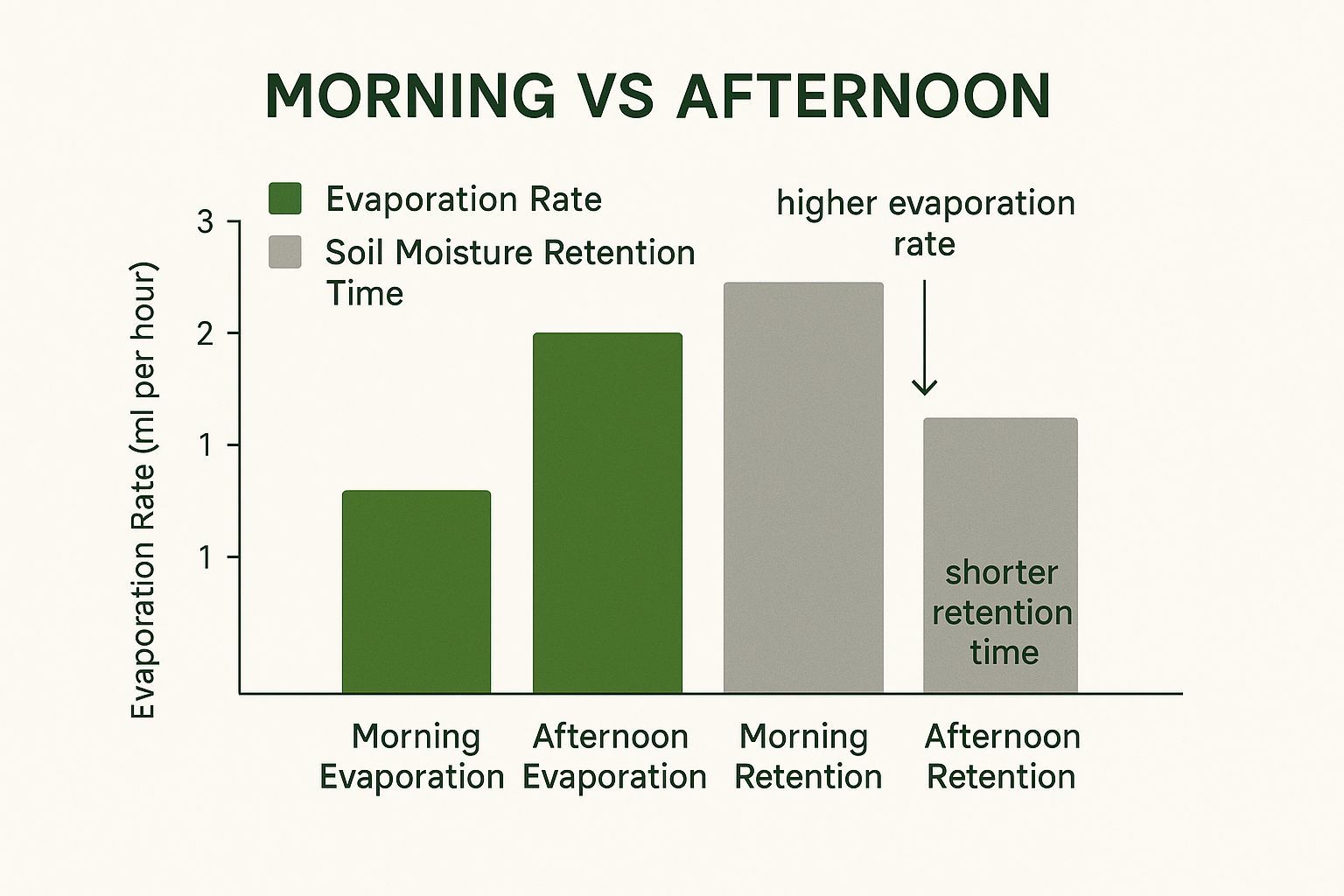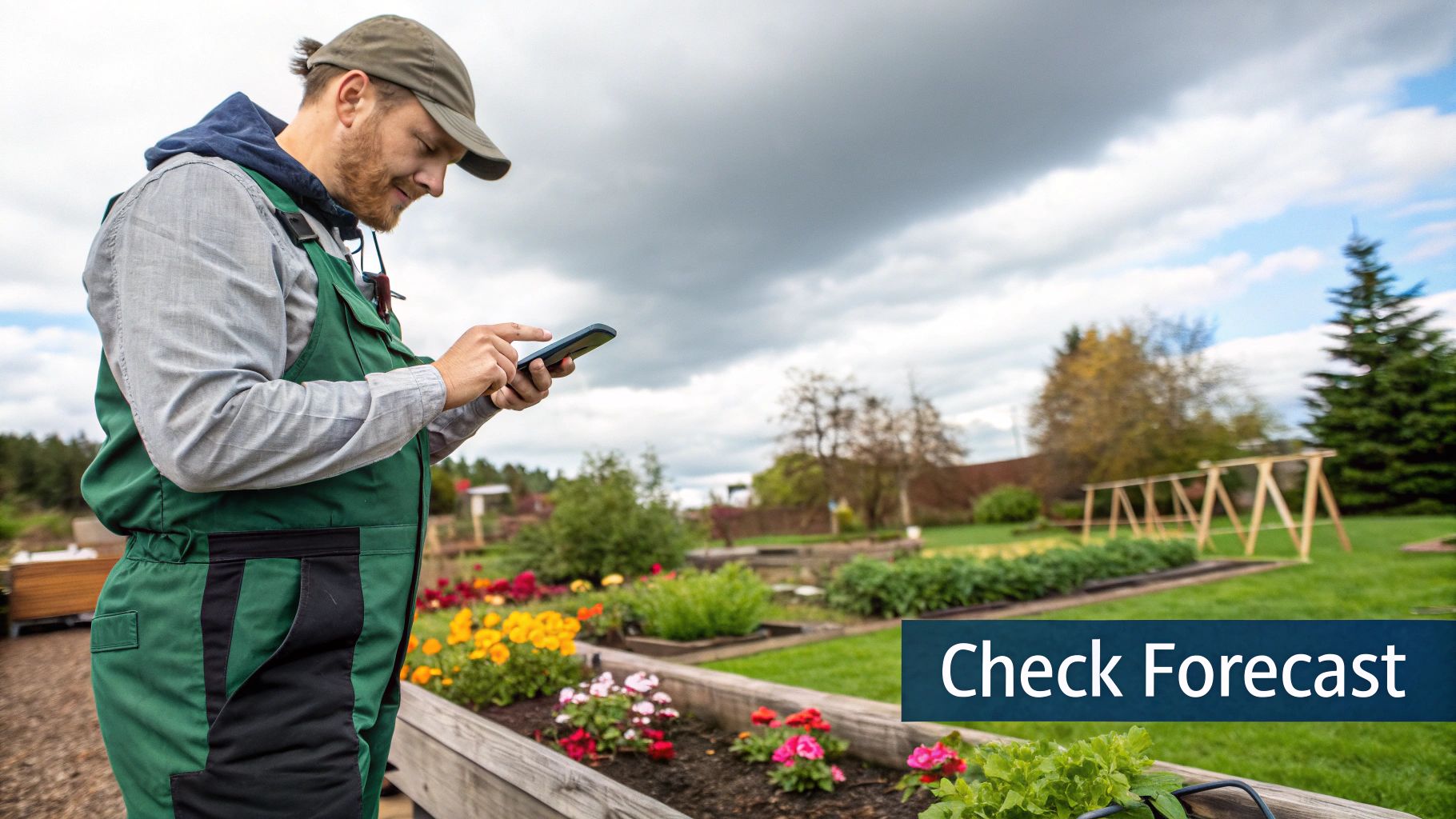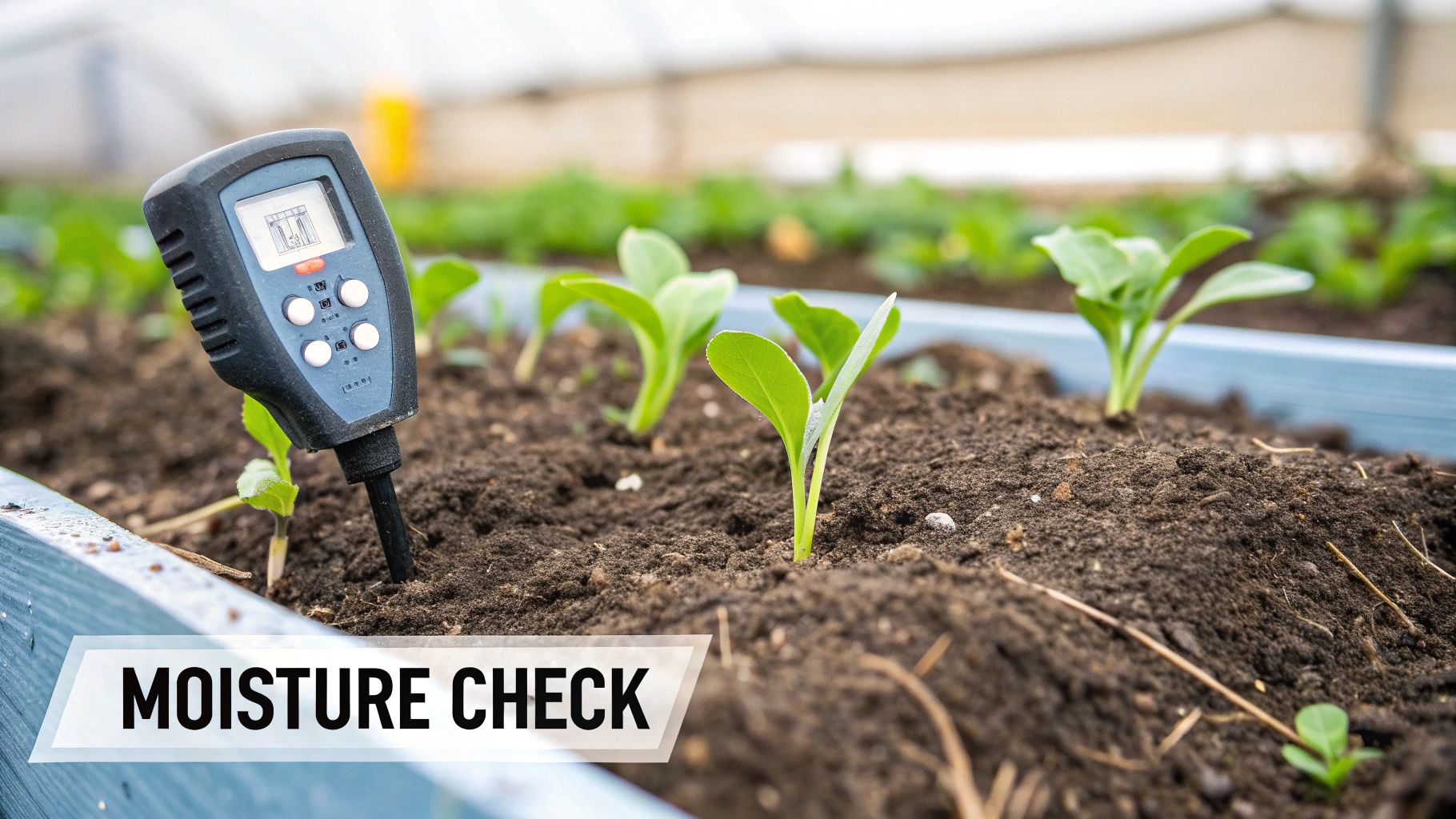
If you ask ten gardeners when to water, you might get ten different answers, but years of experience (and a bit of plant science) point to one clear winner. The absolute best time to water your vegetable garden is in the early morning, ideally between 6 AM and 10 AM.
Getting this timing right is about more than just convenience; it’s a cornerstone of good garden health, water conservation, and disease prevention.
Why Early Morning is Best for Your Plants
Think of it like giving your plants a big drink of water before they head out for a long, hot day. Watering early prepares them for the sun's intensity, ensuring they're well-hydrated before the stress of midday heat kicks in. The goal is to get that water down to the roots where it matters most, not lost to the air.

As you can see, watering in the cool of the morning means far less water is lost to evaporation, keeping the soil moist for your plants throughout the day.
Getting the Most from Every Drop
Watering in the cool morning air is just plain efficient. Evaporation is at its lowest, so the water you apply has time to soak deep into the soil and reach the root zone. Watering during the midday heat, on the other hand, can lead to evaporation losses as high as 30-50%. That’s a huge waste of water and leaves your plants thirsty.
This efficient approach not only saves water but also encourages deep, strong root growth, making your plants more resilient in the long run.
A Simple Trick to Avoid Fungal Problems
Here’s one of the biggest reasons I stick to a morning watering schedule: disease prevention. Damp leaves are an open invitation for fungal issues like powdery mildew, rust, and blight.
When you water in the morning, the sun and breeze have the rest of the day to dry the foliage completely. An evening watering session might seem like a good alternative, but it leaves the leaves wet all night, creating the perfect cool, dark, and damp environment that fungi absolutely adore.
Watering in the morning is one of the easiest, most effective preventative measures you can take. You're actively creating an environment where common garden diseases simply can't get a foothold.
A solid watering schedule goes hand-in-hand with proper planting times. To get your garden started on the right foot, check out our guide on when to plant vegetable seeds.
Morning vs. Evening Watering: A Quick Comparison
While morning is the gold standard, evening is still a viable second choice, especially if your schedule makes morning watering impossible. Here’s a quick breakdown to help you decide what’s best for your garden.
| Factor | Morning Watering (Before 10 AM) | Evening Watering (After 6 PM) |
|---|---|---|
| Water Efficiency | Excellent. Minimal evaporation, maximum soil absorption. | Good. Low evaporation, but water sits on soil overnight. |
| Disease Prevention | Excellent. Foliage dries quickly in the sun, preventing fungal growth. | Poor. Leaves stay wet overnight, creating ideal conditions for mildew and blight. |
| Plant Hydration | Excellent. Prepares plants for the heat of the day. | Good. Rehydrates plants after a hot day, but they enter the night wet. |
| Weed Growth | Less encouragement for weed germination on the surface. | Can encourage germination of weed seeds on the damp surface overnight. |
Ultimately, both are far better than watering in the middle of a hot, sunny day. However, for the healthiest, most resilient garden, a consistent morning routine is the undisputed champion.
How Deeply and How Often to Water Your Plants
When it comes to watering, timing is only half the battle. How you water is just as critical, and it’s where I see a lot of new gardeners go wrong. It feels intuitive to give your plants a light sprinkle every day, but that can actually do more harm than good.
What your vegetables are really asking for is a deep, thorough drink, just less often. This simple change encourages their roots to dig deeper into the soil searching for moisture, which builds a much stronger, more resilient plant that can handle a bit of a dry spell.

The goal is to let the water soak down several inches, getting to the entire root zone. A quick, light spray only wets the top inch or so, which evaporates in a flash and encourages a shallow, weak root system.
Applying the One-Inch Per Week Rule
A good rule of thumb for an established vegetable patch is to give it about 1 to 2 inches of water per week. The key is to deliver this in one to three deep soakings, not daily. This approach not only builds those strong roots we talked about but also cuts down on diseases that thrive on constantly wet leaves.
Of course, this is just a starting point. You’ll need to adjust based on your climate, soil type, and what you’re growing. You can find some great additional tips on vegetable garden watering frequency on LawnLove.com.
So, how do you know what an "inch" of water even looks like? It's easier than you think. Here's a simple trick I've used for years:
- The Tuna Can Test: Grab a few empty tuna cans (or any small, straight-sided container) and scatter them around your garden where the sprinkler hits.
- Time It Out: Turn on your sprinkler and keep an eye on your watch. See how long it takes for the cans to collect one full inch of water.
- Know Your Number: That's it! Now you know exactly how long you need to run your system for a perfect deep-watering session.
A plant’s water needs are always changing. A tiny seedling needs gentle, frequent sips to get started. But a big, fruit-loaded tomato plant is thirsty and needs a whole lot more water, delivered deep down, to keep producing.
By shifting your focus to deep, infrequent watering, you're essentially training your plants to be tougher. It’s a small change in technique that saves water, cuts down on your garden chores, and leads to a healthier, more productive harvest.
Adjusting Your Watering for Weather and Climate
One of the biggest mistakes I see new gardeners make is sticking to a rigid watering schedule. But experienced growers know that a truly great harvest comes from being responsive. Your watering strategy needs to be as dynamic as the weather itself, because a fixed routine just won't work when a surprise heatwave hits or an unexpected downpour soaks your soil.
Learning to be a responsive gardener means you're paying close attention to what's happening right outside your door. You'll need to adjust your routine for intense heat, sudden rain, and even high winds, which can strip moisture from both the soil and your plants' leaves surprisingly fast.

The 10-Degree Rule for Hot Weather
When temperatures start to climb, I rely on a handy guideline I call the "10-degree rule." Research shows that a plant's water needs shoot up with the heat. We often hear the standard advice of 1 inch of water per week, but that can easily double in hot, dry weather.
Here’s how the rule works: For every 10°F the average temperature rises above 60°F, your vegetables will likely need an extra ½ inch of water that week. You can find more detail on specific vegetable water requirements on BonniePlants.com.
This gives you a solid, actionable plan for those scorching summer days and helps keep your plants from getting stressed. For instance, if the forecast jumps from the 70s to the 90s, you know it's time to provide a lot more water. This is especially critical for thirsty root crops; our guide on how to grow potatoes has some great tips for keeping them perfectly hydrated.
The most important skill you can develop is observation. Rules and schedules are helpful, but nothing beats learning to read the subtle cues your plants give you when they are thirsty.
At the end of the day, any formula is just a starting point. The real key is to watch your plants. Pay attention to their leaves. Do they wilt a bit in the hot afternoon sun but perk back up by evening? That's perfectly normal. But if they're still drooping in the cool of the morning, that's a crystal-clear sign they are genuinely thirsty and need a deep drink, fast.
Smart Watering Techniques That Save Time and Water
https://www.youtube.com/embed/ml0LZ9t55I8
Choosing the right tools for the job is a total game-changer in the garden. It's not just about saving you precious time, though it certainly does that. It's about conserving water and, ultimately, growing healthier, more productive plants. Once you move beyond a simple watering can, you open up a whole new world of efficiency.
The best methods all have one thing in common: they deliver water directly to the soil, right where the plant's roots are. This targeted approach dramatically cuts down on evaporation from the sun and wind. Just as important, it keeps the plant's leaves dry, which is your best defense against many common fungal diseases like powdery mildew.
Choosing Your Irrigation Method
Let's talk about two of the most effective systems I've used in home gardens: soaker hoses and drip lines. Both are absolute champions of water efficiency.
-
Soaker Hoses: These are fantastic. They’re basically porous hoses that "weep" water slowly along their entire length. You just snake one through your garden beds, maybe cover it with a bit of mulch, and turn on the tap. It’s an incredibly simple way to give your plants the slow, deep soaking they love.
-
Drip Irrigation: This method takes precision to the next level. It uses flexible tubing with small emitters that you place right at the base of each plant. You get a ton of control, making sure every single drop goes exactly where it’s needed most. Setting up a basic drip system can be a really satisfying weekend project.
My personal pro-tip is to always have a watering wand handy, especially for my containers and newly sprouted seedlings. The long reach lets you get water right to the soil without bending over or accidentally flattening delicate little plants, and the gentle "shower" setting is much better for them than a harsh blast from a hose.
For those with larger vegetable plots or small-scale farms, efficient water collection becomes a critical piece of the puzzle. It’s worth looking into why large plastic storage tanks are often a key component for feeding these more advanced irrigation setups.
By investing in a smarter system, you’re not just saving water—you’re building a more resilient and less demanding garden.
How to Read Your Soil and Plants for Clues
Your vegetable garden is constantly communicating its needs—you just have to learn the language. While a set schedule is a great starting point, the real art of watering comes from becoming a garden detective. Learning to read the subtle clues from your soil and plants will elevate your gardening game and help you build a truly responsive routine.

The most direct way to know if your garden needs a drink is to get your hands dirty. The classic "finger test" has never failed me. Just stick your index finger a couple of inches into the soil near the base of a plant. If it feels dry down at the tip, it's time to water. If you feel moisture, you can hold off for another day or so.
Decoding Plant Behavior
Your plants are the most obvious storytellers in the garden, but their signals can be tricky to interpret correctly.
It's completely normal to see plants with big leaves, like squash or cucumbers, droop dramatically in the afternoon heat. This is often just a defense mechanism called transpiration, where the plant wilts to conserve water. Don't panic! Check on them again as the evening cools down. If they’ve perked back up, they were just fine.
Persistent wilting is the real red flag. If your plants are still drooping in the cool of the early morning, they are genuinely thirsty and need water immediately. This is a clear sign that they didn’t get enough moisture the previous day.
Knowing your soil type is another huge piece of the puzzle. It directly impacts how often you'll need to water.
- Sandy soil feels gritty and drains very quickly, meaning it will need more frequent, lighter waterings.
- Clay soil is dense and holds onto moisture for a long time, so you can water less often but more deeply.
One of the best things you can do for your garden is to add a 2-3 inch layer of organic mulch, like straw or shredded leaves. This simple step works wonders for retaining soil moisture and cutting down on your watering duties. It's especially useful as you get ready for cooler weather and different crops. For more ideas on that, check out our guide on vegetables to plant for the fall season.
Answering Your Top Watering Questions
Even with a solid plan, gardening always throws a few curveballs. Over the years, I've heard just about every watering question imaginable, from dealing with packed schedules to outsmarting the weather. Here are the answers to some of the most common dilemmas I see gardeners face.
Is It Ever Okay to Water in the Evening?
Look, morning is always best. But let's be realistic—sometimes life gets in the way. If your schedule just doesn't work for a morning session, evening is your next-best bet.
The real danger here is leaving your plants' leaves wet overnight. That’s an open invitation for fungal diseases like blight and powdery mildew to move in. If you have to water in the evening, try to do it a little earlier, not right at dusk. The most important thing is to aim the water directly at the base of the plants. Keep the leaves as dry as possible. This is where tools like soaker hoses or drip irrigation are your best friends; they make evening watering much safer.
What Are the Signs of Overwatering?
This is a classic rookie mistake, and it's tricky because overwatered plants can look a lot like underwatered ones. A wilting plant doesn't always mean it's thirsty! It's easy to panic and give it even more water, which just makes things worse.
Be on the lookout for these classic signs of too much water:
- Yellowing leaves, especially starting with the lower, older ones.
- Plants that are wilting even though the soil around them is clearly damp.
- Stunted or slow growth, because the roots are literally drowning and can't get oxygen.
- A sour smell coming from the soil, or you might see green algae forming on the surface.
If you think you've been a little too heavy-handed with the hose, just back off. Let the soil dry out for a day or two. Always, always stick your finger a few inches into the soil to check the moisture before you even think about watering again. Remember, roots need air just as much as they need water.
Should I Still Water if Rain Is in the Forecast?
This really comes down to what kind of rain is coming. A quick, misty shower that barely darkens the pavement isn't going to do much for your plants' deep roots. If that’s all that's predicted, go ahead and stick to your watering schedule.
On the other hand, if you're expecting a good, soaking rain of half an inch or more, you can absolutely take the day off. My best advice? Get a simple rain gauge. It's a cheap and incredibly useful tool that eliminates all the guesswork. It tells you exactly how much water mother nature has provided, so you never accidentally waterlog your garden.
At Homegrown Garden, we're passionate about helping you succeed. From heirloom seeds to our comprehensive grow guides, we provide everything you need to cultivate a thriving garden. Explore our collections and start your growing journey today.



